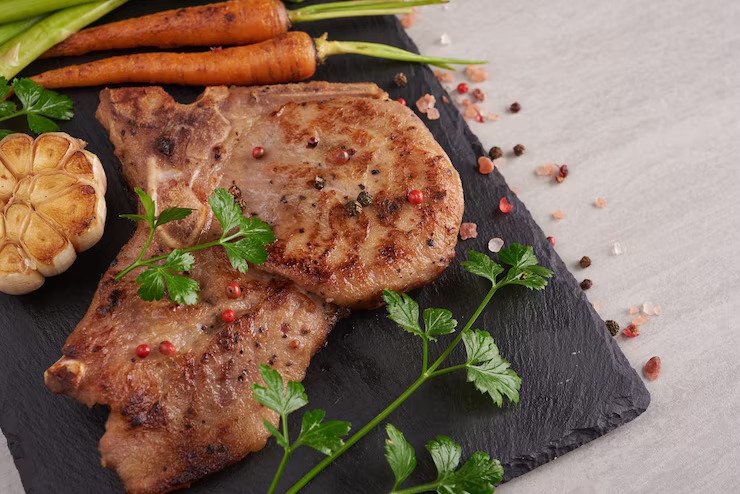Luxembourg, a small yet culturally rich country nestled between Belgium, France, and Germany, offers a culinary landscape that is often overshadowed by its larger neighbors. However, those willing to explore its gastronomic offerings will be rewarded with a unique blend of flavors that reflect the country’s diverse heritage. From hearty meat dishes to indulgent pastries, Luxembourg’s cuisine has something to tantalize every palate.
Among the must-try foods in Luxembourg, Judd mat Gaardebounen stands out as a national dish. This robust meal features smoked pork neck served with a generous helping of broad beans, offering a comforting taste of Luxembourg’s rustic culinary roots. For those seeking something lighter yet equally traditional, the Bouneschlupp, or green bean soup, provides a savory option. This dish, often enriched with potatoes, bacon, and onions, is a testament to the country’s affinity for simple, yet satisfying fare.
Luxembourg’s culinary offerings extend beyond soups and stews. The Gromperekichelcher, or potato fritters, are a popular street food, crispy on the outside and tender within, often accompanied by a tangy apple sauce. For a taste of local charcuterie, the Rieslingspaschteit cannot be missed. This wine-infused pork pie, encased in a flaky crust, is a perfect representation of the region’s skillful use of wine in cooking.
For those with a penchant for traditional sausages, Traipen, also known as black pudding, offers a rich and flavorful experience. Made with blood, oatmeal, and a mixture of spices, it is often served with apple sauce or mashed potatoes, highlighting the country’s ability to balance robust flavors with subtle accompaniments. To satisfy a sweet tooth, the Quetschentaart, or plum tart, provides a delightful end to any meal. This dessert, with its buttery pastry and sweet-tart plum filling, is a testament to Luxembourg’s prowess in pastry-making.
In Luxembourg, each dish tells a story, weaving together the threads of its cultural tapestry. Whether you’re indulging in a hearty Judd mat Gaardebounen or savoring the delicate sweetness of a Quetschentaart, the country’s cuisine offers a journey through flavors that are both familiar and distinctly Luxembourgish. So, when visiting this charming nation, be sure to dive into its rich culinary offerings and discover the tastes that define this unique corner of Europe.
What Food to Try in Luxembourg?
Luxembourg, a small yet culturally rich country, offers a culinary landscape that draws from its unique position at the crossroads of Europe. While French and German influences are evident, Luxembourg has developed its own distinctive gastronomy that reflects both historical traditions and local produce. The dishes you encounter here are more than just meals; these represent the country’s culinary heritage, each telling a story of its past and present.
Gromperekichelcher: The Crispy Potato Delight
One cannot discuss Luxembourgish cuisine without mentioning Gromperekichelcher. These savory potato fritters are seasoned with onions, parsley, and a hint of nutmeg, then fried to golden perfection. They are a staple at local markets and festivals, best enjoyed hot and fresh. Whether accompanied by applesauce or as a side to a hearty meal, they offer a comforting taste that locals hold dear.
Judd mat Gaardebounen: A Hearty Traditional Dish
When exploring traditional Luxembourgish fare, Judd mat Gaardebounen is a must-try. This dish features smoked pork collar, slowly cooked until tender, served with broad beans in a creamy sauce. The smoky flavor of the meat pairs wonderfully with the richness of the beans, making it a beloved classic among Luxembourgers. It is often served with boiled potatoes, making for a filling and satisfying meal.
For those seeking a taste of Luxembourg’s sweet offerings, the Quetschentaart, or plum tart, is a dessert not to be missed. Made with ripe, juicy plums atop a buttery crust, this tart captures the essence of local fruit harvests and is a perfect way to end any meal on a sweet note.
These dishes provide just a glimpse into the culinary tapestry of Luxembourg. Each bite offers a connection to the country’s agricultural heritage, showcasing ingredients that are both locally sourced and seasonally inspired. Exploring Luxembourg through its food is an experience that reveals the nation’s deep-rooted traditions and the warmth of its people.
Discovering Luxembourg’s Unique Pastries: From Quetschentaart to Bretzel
Luxembourg, a European culinary crossroad, offers a range of traditional pastries that reflect its rich cultural tapestry. As you explore the must try foods in Luxembourg, you’ll find that the sweet and savory pastries hold a special place in its gastronomic landscape. Among these, the Quetschentaart stands out as a quintessential treat. This plum tart combines the tartness of ripe plums with a sweet, buttery crust, creating a balance that is both comforting and refreshing. Often enjoyed during the plum harvest season, it embodies the essence of Luxembourg’s penchant for using local, seasonal ingredients.
Another pastry that demands attention is the Bretzel, a Luxembourgish variant of the more commonly known pretzel. This delicacy, traditionally consumed during Bretzelsonndeg (Pretzel Sunday), is a symbol of love and friendship. Made from a slightly sweet dough and often adorned with almonds and sugar, it offers a delightful contrast to the savory pretzels found elsewhere in Europe. During the Lenten season, exchanging a Bretzel is a cherished tradition, emphasizing the pastry’s cultural significance.
While these pastries are highlights, Luxembourg’s culinary scene offers a variety of other notable dishes. The savory Judd mat Gaardebounen, a smoked pork neck dish, and Bouneschlupp, a hearty green bean soup, showcase the country’s love for robust flavors. Gromperekichelcher, or potato fritters, provide a crispy, satisfying snack that perfectly complements a glass of local beer. For those seeking a blend of sweet and savory, the Rieslingspaschteit, a wine-infused pork pie, offers a unique taste experience. Meanwhile, the Traipen, a Luxembourgish take on black pudding, delivers a rich, spicy profile that pairs beautifully with traditional sides.
Luxembourg’s pastries and dishes are more than just culinary offerings; they are a reflection of the country’s history and traditions. Each bite tells a story of regional influences and local ingredients, making the exploration of these foods an integral part of any visit to this small but flavor-packed nation. So, whether you find yourself savoring a slice of Quetschentaart or sharing a Bretzel, you’re participating in a culinary heritage that is both unique and deeply rooted in Luxembourgish culture.
Exploring Hearty Luxembourgish Dishes: Judd mat Gaardebounen and Beyond
Luxembourg’s culinary scene, while often overshadowed by its larger neighbors, offers a wealth of traditional dishes that reflect the rich agricultural and cultural heritage of the country. At the forefront of this gastronomic experience is ‘Judd mat Gaardebounen,’ a dish that encapsulates the essence of Luxembourgish cuisine. This robust meal features smoked pork collar simmered to perfection alongside broad beans, creating a harmonious blend of flavors that speak volumes about the country’s culinary traditions.
Judd mat Gaardebounen is typically served with boiled potatoes, often infused with a hint of mustard, which complement the savory richness of the pork. The dish is a staple at local festivals and family gatherings, symbolizing a deep-rooted connection to Luxembourg’s rural past. When enjoyed with a glass of local Riesling, it provides an authentic taste of the region’s gastronomic offerings.
Beyond Judd mat Gaardebounen, Luxembourg presents a variety of other traditional dishes that showcase the country’s culinary heritage. Bouneschlupp, a hearty green bean soup, often includes smoked bacon and potatoes, offering a comforting dish perfect for colder months. Another local favorite is Kachkeis, a soft cheese spread typically served warm with bread or potatoes, highlighting the region’s affinity for dairy products.
For those looking to explore further, Luxembourg’s diverse culinary landscape includes Gromperekichelcher, crispy potato pancakes seasoned with parsley and onions, often found at street markets and fairs. The sweet side of Luxembourg’s gastronomy should not be overlooked either, with Quetschentaart, a traditional plum tart, and Verwurelter, a type of twisted doughnut, providing delightful conclusions to any meal.
Sampling these dishes not only offers a taste of Luxembourg’s rich culinary traditions but also provides insight into the local way of life. The country’s cuisine, characterized by its emphasis on hearty, comforting foods, is a testament to its agricultural roots and cultural influences. Whether at a cozy local bistro or a bustling market stall, the flavors of Luxembourg invite you to savor a unique and authentic European dining experience.
Sipping Luxurious Luxembourg Wines and Craft Beers: A Guide to Local Delights
Luxembourg’s culinary landscape offers a rich tapestry of flavors, deeply intertwined with its robust tradition of winemaking and burgeoning craft beer scene. As you explore the grand duchy’s offerings, the must try foods in Luxembourg include judd mat gaardebounen, green bean soup or bouneschlupp, gromperekichelcher potato fritters, rieslingspaschteit, a wine-infused pork pie, traipen or black pudding, and the sweet quetschentaart plum tart. Pair these dishes with some of the finest local wines and beers, and you have a gastronomic experience that is both indulgent and uniquely Luxembourgish.
Luxembourg is particularly renowned for its Moselle valley, a region celebrated for crafting exceptional white wines. The valley’s climate and terroir contribute to the production of crisp, aromatic wines, with Riesling, Pinot Gris, and Auxerrois leading the charge. A visit to this picturesque region offers the chance to savor these varietals directly from the source. A glass of Riesling, with its distinct minerality and fresh citrus notes, complements the rich smokiness of judd mat gaardebounen, a traditional smoked pork collar dish served with broad beans.
Moving beyond wine, Luxembourg’s craft beer scene has seen a vibrant evolution in recent years. Microbreweries now dot the landscape, each offering unique brews that reflect both traditional techniques and modern innovations. Opt for a hoppy pale ale or a rich stout to accompany the hearty bouneschlupp. The subtle bitterness of the ale or the deep maltiness of the stout perfectly balances the soup’s creamy texture and savory profile.
For those with a penchant for pastry, rieslingspaschteit provides an intriguing intersection of food and wine. This savory pie combines tender pork with the aromatic infusion of local Riesling, delivering a sophisticated flavor that pairs beautifully with a glass of Auxerrois, known for its softer acidity and fruity undertones.
Finally, no exploration of Luxembourg’s food and drink traditions is complete without indulging in the local quetschentaart. This quintessential plum tart, with its buttery crust and sweet, juicy plums, finds a delightful partner in a chilled glass of Cremant de Luxembourg. The sparkling wine’s effervescence and delicate fruit notes enhance the tart’s sweetness, providing a refreshing end to a meal.
- Riesling: Pairs well with judd mat gaardebounen
- Pale Ale or Stout: Complements bouneschlupp
- Auxerrois: Matches rieslingspaschteit
- Cremant de Luxembourg: Perfect with quetschentaart
In Luxembourg, the art of pairing food with wine and beer is celebrated as a way to elevate each culinary element, ensuring that every meal is a memorable experience. Whether you’re a connoisseur of fine wines or a craft beer enthusiast, Luxembourg’s offerings promise a journey through flavors that are as diverse as they are delicious.










